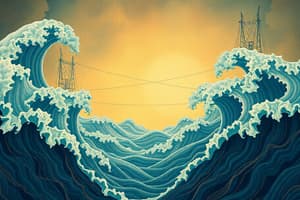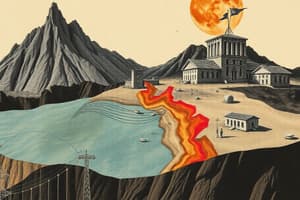Podcast
Questions and Answers
What causes an earthquake?
What causes an earthquake?
- Volcanic eruptions
- Increase in atmospheric pressure
- Rapid cooling of the earth's crust
- Movement within the earth's crust (correct)
How is the behavior of earthquake waves measured?
How is the behavior of earthquake waves measured?
- By analyzing river flow patterns
- Using telescopes
- Using delicate instruments called seismographs (correct)
- By observing cloud patterns
Where do most earthquakes occur?
Where do most earthquakes occur?
- Inside volcanic chambers
- In deep ocean trenches
- Along the boundaries between tectonic plates (correct)
- In the Earth's core
What primarily drives the motion of tectonic plates?
What primarily drives the motion of tectonic plates?
How do scientists record the motion of earthquake waves?
How do scientists record the motion of earthquake waves?
What is the surficial expression of an earthquake?
What is the surficial expression of an earthquake?
Which type of seismic wave causes elliptical shaking?
Which type of seismic wave causes elliptical shaking?
What triggers different types of earthquakes?
What triggers different types of earthquakes?
During which stage does water rush back into the cracks, reducing the rock's strength?
During which stage does water rush back into the cracks, reducing the rock's strength?
What is the most common type of earthquake?
What is the most common type of earthquake?
Flashcards are hidden until you start studying
Study Notes
- Earthquakes can occur both on land and underwater, and underwater quakes can cause tsunamis.
- Tsunamis are large water waves that cause surges up to 100 feet high and lead to destruction.
- Not all earthquakes occur on tectonic plate boundaries; some occur on intraplate faults, like the New Madrid Fault.
- An earthquake consists of three main parts: the focus (origin), seismic waves, and the fault line.
- The focus is the location of the earthquake at depth, and the epicenter is the surficial expression of the earthquake.
- There are four types of seismic waves: P-waves (fastest, compressional), S-waves (second, transverse), Rayleigh waves (longitudinal, cause elliptical shaking), and Love waves (transverse, cause side-to-side shaking).
- Three main types of faults exist: Thrust (reverse, vertical), Normal (vertical, one block moves downward), and Strike-slip (horizontal, blocks move past each other).
- Earthquakes occur when tectonic plates move against each other, releasing stress in the form of seismic waves.
- Stress can be compressional, tensional, or shear, and triggers different types of earthquakes.
- Tectonic earthquakes are the most common, but there are other types, such as volcanic, collapse, and explosion earthquakes.
- Earthquakes go through five stages: Elastic build-up, dilatancy, influx of water, earthquake, and post-earthquake.
- The elastic build-up stage involves rocks compressing together, followed by the dilatancy stage where rocks crack and water is forced out.
- During the influx of water stage, water rushes back into the cracks, reducing the rock's strength.
- The earthquake stage is the actual quake, while the post-earthquake stage involves aftershocks and ground settling.
Studying That Suits You
Use AI to generate personalized quizzes and flashcards to suit your learning preferences.




